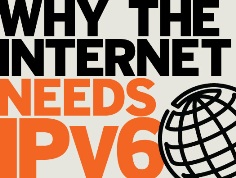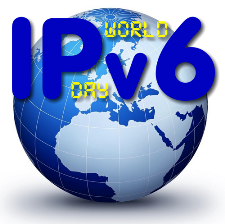The Internet is completely full.
Of what, there is much discussion and debate.
Nevertheless, the Internet Society has named today as World IPv6 launch day.
It’s the start of a new version of the Internet, one in which a whole new standard of operation begins to become a normal part of the online and mobile experience.
It’s not supposed to impact or affect the availability of any consumer or business services, but the added level of complexity that comes with managing new and old networks, devices and services while supporting both IPv6 and IPv4 will present some challenges for providers.
IPv6 is about the explosive growth of Internet-connected devices, including smartphones and smart TVs, but beyond consumer products to M2M and so much more.
The Internet address book is what’s full; according to the Number Resource Organization, the world officially ran out of IPv4 addresses in February 2011 when the IANA IP address pool was depleted.
So there’s a big need for more IP addresses than are possible with IPv4; hence, IPv6 was introduced, and major ISPs, content providers and even home router manufacturers are permanently launching IPv6 for their products and services this month (while still supporting the current IPv4 standard).
Here in Canada, Telus is alone among the country’s big three ISPs that had listed its readiness on the society’s launch page.
But Videotron was among the earliest Canadian providers to offer access to IPv6 addresses. Other companies have been running tests and ‘experimental trials’, and some, including providers like Bell, offer consulting services and resources in anticipation of wider roll-out and customer adoption in the future.
CANARIE, Canada’s Advanced Research and Innovation Network, and BCNET, the Shared IT Services Organization for Higher Education in British Columbia and Cisco have created an IPv6 Community Lab, a network test-bed to provide real-time resources to help network administrators get hands-on IPv6 experience.
They’re are offering universities and colleges free access to an IPv6 Community Lab to help prepare their networks for the unavoidable upgrade from Internet Protocol version 4 (IPv4) to Internet Protocol version 6 (IPv6).
CANARIE has been IPv6-enabled since 2000.
“The support of IPv6 from these thousands of organizations delivers a critical message to the world: IPv6 is not just a ‘nice to have’; it is ready for business today and will very soon be a ‘must have,’” said Leslie Daigle, Chief Internet Technology Officer, Internet Society. “We believe that the commitment of these companies to deploy IPv6 will ensure that they remain industry leaders. Any company wishing to be effective in the new Internet should do the same.”
There was an IPv6 test day last year, and (hopefully) lots of pre-testing, load balancing and back up system installing before today’s official launch.

World IPv6 Launch is organized by the Internet Society as part of its mission to ensure that the Internet remains open and accessible
Everyone knows that even temporary, intermittent issues could negatively impact the customer experience, so working to avoid that has been uppermost on the minds of many operators, according to the technical analysts at industry consulting firm Ovum:
“Discussions with equipment vendors have convinced Ovum that implementing IPv6 is mainly a software or firmware issue for most network equipment, although older home residential gateways may require replacement,” they wrote in an IPv6 paper. “Most recent vintage computers and servers are IPv6 ready. Microsoft Vista, Windows 7, and MAC OSX 10.7 all have IPv6 enabled by default. For mobile devices, the Android and Apple iOS operating systems enable IPv6 by default, so when IPv6 is enabled by carriers, in many cases user’s equipment will just automatically connect to the Internet using IPv6.”
Even so, Mike Sapien, enterprise telecoms analyst at Ovum, notes there are customers only now starting to realise the importance of supporting IPv6:
“Although an obvious catalyst is the lack of IPv4 address space, we at Ovum have seen other factors in the migration or transition to IPv6. The proliferation of devices, mobile access to resources and B2C applications are driving customers to support IPv6. In addition, this isn’t really a complete migration – it is more of a dual-support capability that will be enabled for many years to come. Ovum research, for an upcoming IPv6 report, has revealed that B2C applications are one of the common drivers for customers, including service providers, moving to IPv6.”
Ovum also noted the progress that specific providers have made, mentioning that the Verizon LTE network is enabled for IPv6, and the company is testing IPv6 on its FiOS network, for example Also in the U.S., AT&T is offering IPv6 commercial services, Comcast has some IPv6 on its residential wireline platform, and Time Warner is also offering IPv6 to residential subscribers.
ISPs in Australia and Hong Kong are among the international supporters with IPv6 offerings, and among them, Canadian company Sandvine, a developer and provider of network technology and related services, is a big supporter.
Sandvine has successfully completed IPv6 protocol testing for a major South East Asian DSL company, one that has close to two million subscribers.
“Service providers … are adding a significant number of new broadband subscribers each year and have a real need to bring IPv6 to their networks,” said Tom Donnelly, COO, Sales and Global Services, Sandvine, adding that his company provides ISP tools for the measurement and management of IPv4 and IPv6 traffic simultaneously across all access technologies.
By the way, while everyone’s working so hard to create billions and billions of new addresses (new numbers), you may wonder just where another number, IPv5, went.
It does – or did – exist, and was known as the Internet Stream Protocol backs in the 1980s, when it was developed to help transmit audio, video over the Internet. However, it was never used as an official protocol, and not widely distributed, although parts were adapted and developed into what’s now known VoIP, and MPLS, a multiprotocol network switching standard.
World IPv6 Launch is organized by the Internet Society as part of its mission to ensure that the Internet remains open and accessible for everyone – including the other five billion people not yet connected to the Internet.
# # #
submitted by Lee Rickwood





